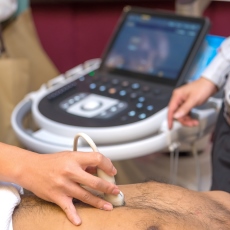
Gallbladder Cancer
New on the MedlinePlus Gallbladder Cancer page:

MEDICAL ENCYCLOPEDIA
National Institutes of Health
Your gallbladder is a pear-shaped organ under your liver. It stores bile, a fluid made by your liver to digest fat. As your stomach and intestines digest food, your gallbladder releases bile through a tube called the common bile duct. The duct connects your gallbladder and liver to your small intestine.
Cancer of the gallbladder is rare. It is more common in women and Native Americans. Symptoms include
- Jaundice (yellowing of the skin and whites of the eyes)
- Pain above the stomach
- Fever
- Nausea and vomiting
- Bloating
- Lumps in the abdomen
It is hard to diagnose gallbladder cancer in its early stages. Sometimes doctors find it when they remove the gallbladder for another reason. But people with gallstones rarely have gallbladder cancer. Because it is often found late, it can be hard to treat gallbladder cancer. Treatment options include surgery, chemotherapy, radiation, or a combination.
NIH: National Cancer Institute
- Abdominal Ultrasound (American College of Radiology, Radiological Society of North America)Also in Spanish
- CEA (Carcinoembryonic Antigen) Test (American Association for Clinical Chemistry)
- ERCP (Endoscopic Retrograde Cholangiopancreatography)
 (National Institute of Diabetes and Digestive and Kidney Diseases)Also in Spanish
(National Institute of Diabetes and Digestive and Kidney Diseases)Also in Spanish - How Is Gallbladder Cancer Diagnosed? (American Cancer Society)Also in Spanish
- Liver Function Tests: MedlinePlus Health Topic
 (National Library of Medicine)Also in Spanish
(National Library of Medicine)Also in Spanish - Magnetic Resonance Cholangiopancreatography (MRCP)(American College of Radiology, Radiological Society of North America)Also in Spanish
- Stages of Gallbladder Cancer
 (National Cancer Institute)Also in Spanish
(National Cancer Institute)Also in Spanish
- Can Gallbladder Cancer Be Prevented? (American Cancer Society)Also in Spanish
- Chemotherapy for Gallbladder Cancer (American Cancer Society)Also in Spanish
- Gallbladder Cancer: Surgery (American Cancer Society)Also in Spanish
- Treatment Option Overview (Gallbladder Cancer)
 (National Cancer Institute)Also in Spanish
(National Cancer Institute)Also in Spanish - Treatment Options for Gallbladder Cancer
 (National Cancer Institute)Also in Spanish
(National Cancer Institute)Also in Spanish
- Living as a Gallbladder Cancer Survivor (American Cancer Society)
- Palliative Therapy for Gallbladder Cancer (American Cancer Society)Also in Spanish
- Gallbladder Polyps: Can They Be Cancerous? (Mayo Foundation for Medical Education and Research)Also in Spanish
- What Are the Risk Factors for Gallbladder Cancer? (American Cancer Society)Also in Spanish
- Gallbladder Cancer Incidence and Death Rates (Centers for Disease Control and Prevention)
- What Are the Key Statistics about Gallbladder Cancer? (American Cancer Society)Also in Spanish
- What's New in Gallbladder Cancer Research and Treatment? (American Cancer Society)Also in Spanish
- ClinicalTrials.gov: Gallbladder Neoplasms
 (National Institutes of Health)
(National Institutes of Health)
- Article: Long-term outcomes and prognostic markers in gallbladder cancer.
- Article: Is Hepatopancreatoduodenectomy an Acceptable Operation for Biliary Cancer?
- Article: Contrast-enhanced ultrasound findings of gallbladder adenocarcinoma with sarcomatoid carcinoma accompanied...
- Gallbladder Cancer -- see more articles
- Dictionary of Cancer Terms
 (National Cancer Institute)Also in Spanish
(National Cancer Institute)Also in Spanish
- American Cancer Society
- Find a Cancer Doctor (American Society of Clinical Oncology)
- National Cancer Institute
 Also in Spanish
Also in Spanish - National Institute of Diabetes and Digestive and Kidney Diseases

- Organizations That Offer Support Services
 (National Cancer Institute)Also in Spanish
(National Cancer Institute)Also in Spanish
- After chemotherapy - discharge (Medical Encyclopedia)Also in Spanish
- Understanding Chemotherapy

 (National Cancer Institute) - PDFAlso in Spanish
(National Cancer Institute) - PDFAlso in Spanish - What to Know about Brachytherapy (A Type of Internal Radiation Therapy)

 (National Cancer Institute) - PDFAlso in Spanish
(National Cancer Institute) - PDFAlso in Spanish - What to Know about External Beam Radiation Therapy

 (National Cancer Institute) - PDFAlso in Spanish
(National Cancer Institute) - PDFAlso in Spanish






















.png)











No hay comentarios:
Publicar un comentario